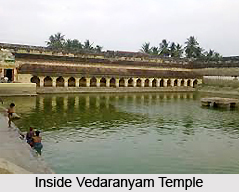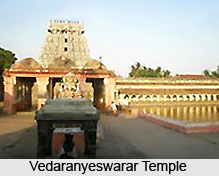 Vedaranyam is a census town in Nagapattinam district of Tamil Nadu. The town is named after the presiding deity of the Vedaranyeswarar Temple. Vedaranyeswarar Temple is one of the important centres of South Indian Hindu community.
Vedaranyam is a census town in Nagapattinam district of Tamil Nadu. The town is named after the presiding deity of the Vedaranyeswarar Temple. Vedaranyeswarar Temple is one of the important centres of South Indian Hindu community.
History of Vedaranyam
History of Vedaranyam says that from the medieval Chola period of the 9th century, Vedaranyam became the centre of pilgrimage. History of Vedaranyam also shows the inscription of Chola king Aditya Chola, who ruled the place from 871 to 907 AD, where one can find the mentioning of this temple by many saints and hermits. Later the Pandyas, Vijayanagar Empire, British East Indian Company and the British Government ruled this place. During the colonial rule in India, C. Rajagopalachari launched a salt march in Vedaranyam parallel to the Dandi March, which was launched by Mahatma Gandhi in 1930 to protest against the sales tax levied on salt extraction.
Vedaranyam got its name after the name of the ancient temple of this place Vedaranyeswarar Temple. The presiding deity of the Vedaranyeswarar Temple is Lord Shiva or Mahadeva. The place was earlier known as Tirumaraikadu. There one can see the 7th century Shaiva canonical work Tevaram by Appar and Tirugnanasambandar mentions the place as Tirumaraikadu.
According to the Vedas, Lord Shiva or Mahadeva was worshipped in this place, giving the name Vedaranyam to the place. According to another Hindu legend, Lord Rama, the seventh avatar of Lord Vishnu, is believed to have visited Vedaranyam to absolve himself from sins committed in the war against the demon king Ravana. The footprints of Lord Rama are preserved in a place called Ramar Padam near Vedaranyam. According to a Tamil legend, the Vedas locked the gates of the temple after worshipping Lord Shiva.
 Location of Vedaranyam
Location of Vedaranyam
Vedaranyam is located on the Coramandel coast of Bay of Bengal. Vedaranyam swamp is located parallel to the Palk Strait for 48 kilometres. Kaveri River was flowing through south easterly direction from Trichy and had its confluence at Vedaranyam due to the emergence of Vedaranyam nose during the pleistocene period. Due to the rise of tertiary rocks in the Pattukottai to Mannargudi region and also due to the increase of sediments in the Vedaranyam area, the river migrated northwards. There is lesser marine activity in the Vedaranyam shore due to the presence of Vedaranyam nose in the north and Sri Lanka in the south, both causing weak shore currents.
Demography of Vedaranyam
According to the Population Census in the year 2011 census, Vedaranyam had a population of 34,266 with a sex-ratio of 1,068 females for every 1,000 males, much above the national average of 929. A total of 3,261 were under the age of six, constituting 1,711 males and 1,550 females. The average literacy of the town was 77.86 percent compared to the national average of 72.99 percent.
Economy of Vedaranyam
Economy of Vedaranyam is largely dependant on the prawn culture and agriculture. The saltpans (crystallisers) are spread over 11,000 acres along the coastline, including those of small, medium and large salt manufacturers. According to estimates, about 3.5 lakh tonnes of salt is produced annually in the region. The salt industry employs around 20,000 people.
Tourism in Vedaranyam
Tourism in Vedaranyam covers mainly the ancient temples of Chola and Pandya times. The Vedaranyeswarar temple is an ancient Hindu temple dedicated to Lord Shiva. The temple has a shrine for Thyagaraja known for Hamsapthanathaanam, the dance pose similar to the gait of a swan. Other temples of Vedaranyam are Dharbaranyeswarar Temple, Kayarohanaswamy Temple, Kannayariamudayar Temple, Brahmapureeswarar Temple, Vaimoornaathar Temple and Tiruvarur Thyagaraja Temple. The Salt Sathyagraga Memorial Stupe was built in memory of the salt march during independence movement in India.



















